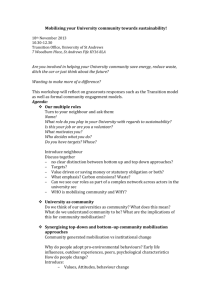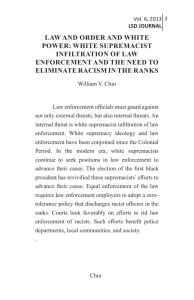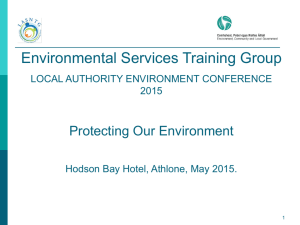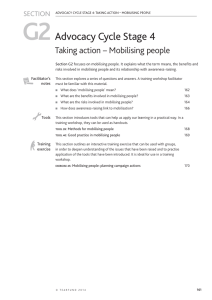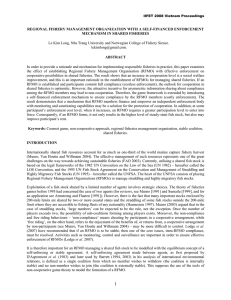Police and Community Led Structural Change: The Asian Century
advertisement
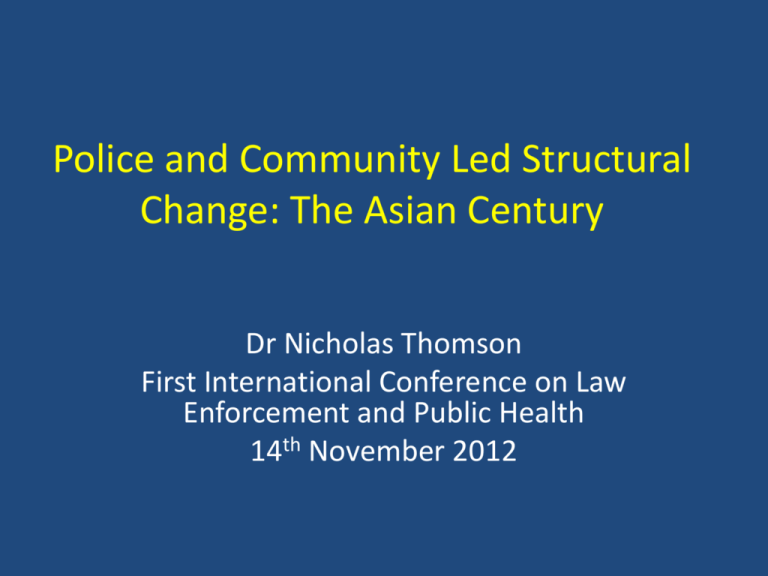
Police and Community Led Structural Change: The Asian Century Dr Nicholas Thomson First International Conference on Law Enforcement and Public Health 14th November 2012 Methodologies • Root Cause Analysis • Forming the coalition of the willing • Mobilising around a common vision, mission and objective • Implementing structural change Applying Community Lead Mobilisation for Structural Change Examples of local and and national structural change initiatives • Reducing Methamphetamine Use and its harms in Northern Thailand • Criminal Justice Reform in the Context of Public Health in Thailand Root Cause Analysis ATS TRAFFICKING IN SE ASIA Shipping ports in the Golden Triangle ATS and Public Health ATS has implications for…………………… • STIs • HIV • Mental Health • Alcohol/Tobacco • Compulsory detention Duration of amphetamine use (yrs) and frequency alcohol use in last 30 days), Chiang Mai, Thailand, 2005 High prevalence of depression (CES-D score >=22) P < .0001 Male = 31% Female = 45% Celentano D D, Aramrattana A, Sutcliffe CG, et.al. (2008) Journal of Adolescent Medicine. 2(2):66-73. THE PROCESS OF COMMUNITY MOBILIZATION Stage 3- Ownership Stage 2Collectivization Stage 1- Identification with others Community Mobilisation at the Local Level A formation of a coalition of the willing at the district level • Multisectoral actors from police, health, education, monks, youth networks, local government………plus a few change agents • Facilitated by dedicated community research team Mobilising a Vision • To reduce the harms associated with methamphetamine us among young people by rebalancing the approach from a law enforcement only approach to one that is underpinned by collaboration between law enforcement and public health…and an approach fundamentally underpinned by human rights Assessing the systems and structures • • • • • • Education System Law Enforcement System Health System Economic and Vocation Systems Peer Networks and Peer Norms Community Understandings Fixing the system: Identifying Structural Change Objectives • Young people suspected of drug possession are automatically expelled or suspended from school • Solution: Ensure that young people considered “at risk” are supported to stay at school • How to do it? Mobilising a working group • Changing the school policing requires effort • Getting the right people engaged – Key Actors • Mobilising them through meetings with experts, education ministry and curriculum advisors Systems Changed Result: School policy changed, “at risk groups” kept at school, curriculum around improved youth decision making implemented Young people in Sankampaeng no longer expelled 70 60 Oct-09 Nov-09 Dec-09 Jan-10 Feb-10 Mar-10 Apr-10 May-10 Jun-10 Jul-10 Aug-10 Sep-10 Oct-10 Nov-10 Dec-10 Jan-11 Feb-11 Mar-11 Apr-11 May-11 Jun-11 Jul-11 Aug-11 Sep-11 Oct-11 Nov-11 Dec-11 Jan-12 Feb-12 Mar-12 Apr-12 May-12 Jun-12 Capturing the data Graph I - Community Mobilization - SanKamPhaeng Data as of September 3, 2012 100 90 80 Community Action** NEW Key Actors SCOs Achieved 50 40 30 20 10 0 Data capture heavy • • • • • • Healthy Coalition Questionnaire Key Informant Interviews Meeting notes Working Group notes Pre Post Structural Change Analysis Ethnographic and Community perception analysis……………….. Justice Health Initiative Similar approach to tackle another relevant system……..at a much higher level • High Level Steering Committee of the Willing and Relevant • Judges, lawyers, Office of Narcotic Control, Director of Health Centres, What does it all mean?? • Creating Partnerships at the Intersection of Law Enforcement and Public Health • RE Enforcing Global Public Health and Security Towards Public Health Armies? • Responding to HIV among Key Affected Populations and drug issues in general is a convenient fractal from which to explore the potential for LE and PH collaborations • How do we internationalise best practices? Think about the potential for reshaping • Operationalising the Intersection of Law Enforcement and Public Health Partnerships • Collaborative Leadership and Vision • Strong and vibrant civil societies • Communication: Formal and Informal Towards a common language • • • • • • • Intersection Interface Standard Operating Procedures MOUs Nexus Joint Operations Taskforces Creating public health armies?
